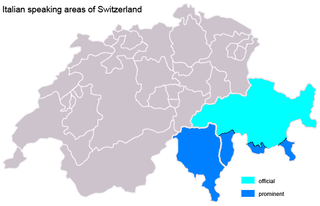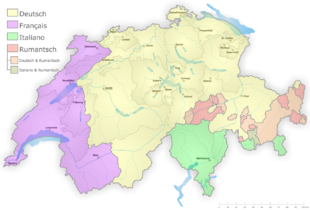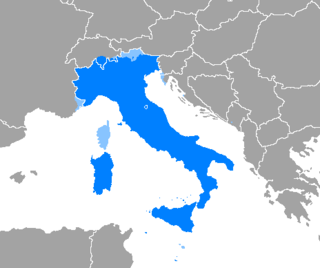
Italian is a Romance language of the Indo-European language family that evolved from the Vulgar Latin of the Roman Empire. Italian is the least divergent Romance language from Latin, together with Sardinian. Spoken by about 85 million people including 67 million native speakers (2024), Italian is an official language in Italy, San Marino, and Switzerland, and is the primary language of Vatican City. It has official minority status in Croatia and in some areas of Slovenian Istria.

The four national languages of Switzerland are German, French, Italian, and Romansh. German, French, and Italian maintain equal status as official languages at the national level within the Federal Administration of the Swiss Confederation, while Romansh is used in dealings with people who speak it. Latin is occasionally used in some formal contexts, particularly to denote the country.

Ticino, sometimes Tessin, officially the Republic and Canton of Ticino or less formally the Canton of Ticino, is one of the 26 cantons forming the Swiss Confederation. It is composed of eight districts and its capital city is Bellinzona. It is also traditionally divided into the Sopraceneri and the Sottoceneri, respectively north and south of Monte Ceneri. Red and blue are the colours of its flag.

The Lombard language belongs to the Gallo-Italic group within the Romance languages and is characterized by a Celtic linguistic substratum and a Lombardic linguistic superstratum and is a cluster of homogeneous dialects that are spoken by millions of speakers in Northern Italy and southern Switzerland, including most of Lombardy and some areas of the neighbouring regions, notably the far eastern side of Piedmont and the extreme western side of Trentino, and in Switzerland in the cantons of Ticino and Graubünden. The language is also spoken in Santa Catarina in Brazil by Lombard immigrants from the Province of Bergamo, in Italy.
Regional Italian is any regional variety of the Italian language.
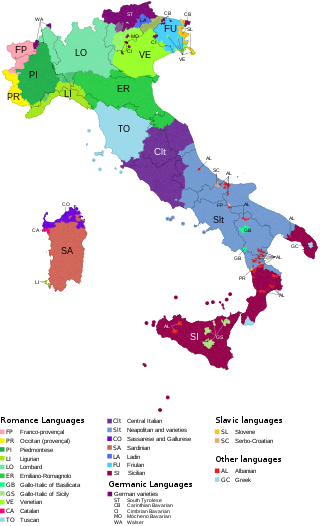
The languages of Italy include Italian, which serves as the country's national language, in its standard and regional forms, as well as numerous local and regional languages, most of which, like Italian, belong to the broader Romance group. The majority of languages often labeled as regional are distributed in a continuum across the regions' administrative boundaries, with speakers from one locale within a single region being typically aware of the features distinguishing their own variety from one of the other places nearby.
The Ticinese dialect is the set of dialects, belonging to the Alpine and Western branch of the Lombard language, spoken in the northern part of the Canton of Ticino (Sopraceneri); the dialects of the region can generally vary from valley to valley, often even between single localities, while retaining the mutual intelligibility that is typical of the Lombard linguistic continuum.
Western Lombard is a group of dialects of Lombard, a Romance language spoken in Italy. It is widespread in the Lombard provinces of Milan, Monza, Varese, Como, Lecco, Sondrio, a small part of Cremona, Lodi and Pavia, and the Piedmont provinces of Novara, Verbano-Cusio-Ossola, the eastern part of the Province of Alessandria (Tortona), a small part of Vercelli (Valsesia), and Switzerland. After the name of the region involved, land of the former Duchy of Milan, this language is often referred to as Insubric or Milanese, or, after Clemente Merlo, Cisabduano.

The Università della Svizzera italiana, sometimes referred to as the University of Lugano in English-speaking contexts, is a public Swiss university established in 1995, with campuses in Lugano, Mendrisio and Bellinzona. USI is the only university in Switzerland where the official language is Italian, but many of its programs are in English.

Radiotelevisione svizzera di lingua italiana is a Swiss public broadcasting organisation, part of SRG SSR. RSI handles production and broadcasting of radio and television programs in Italian and Lombard for Switzerland. RSI's administrative headquarters are located in Via Canevascini in Lugano-Besso.

Intragna is a village and locality in the municipality of Centovalli in the district of Locarno of the canton of Ticino in Switzerland.
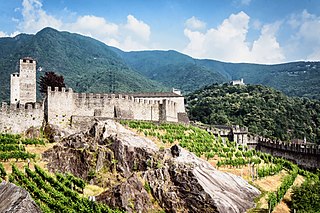
Ticino has a long tradition of winemaking, being the southernmost region of Switzerland. Wine has been produced there since the Roman era. The region is known for its Merlot, which was introduced in the early 20th century.

The pane ticinese is a white bread traditionally made in the Swiss canton of Ticino, but also available in the rest of Switzerland, where it is known as "Bread of Ticino". In Ticino, it is referred to by a number of names specific to the region, including pane riga, reale or lireta.

Italian immigration to Switzerland is related to the Italian diaspora in Switzerland. Italian emigration to Switzerland took place mainly from the end of the 19th century.

Italian Grisons or Italian Grigioni or sometimes also called Lombard Grisons, is the region of the Canton of Grisons, Switzerland, in which Italian is the dominant language.

RSI Rete Tre is the third Italian-language radio station from Radiotelevisione svizzera di lingua italiana (RSI), aimed at younger listeners broadcasting popular and alternative music. It was launched at 00:03 on 1 January 1988 and is available via FM mainly in the Italian-speaking cantons of Ticino and Graubünden. From 15 October 2009, its range was extended to major cities in German-speaking areas of Switzerland with the implementation of a number of DAB+ digital relays

TILO is a limited company established in 2004 as a joint venture between Italian railway company Trenord and Swiss Federal Railways (SBB CFF FFS); both companies participate in the equity of TILO SA with participation of 50%.

Italian irredentism in Switzerland was a political movement that promoted the unification to Italy of the Italian-speaking areas of Switzerland during the Risorgimento.
Maurizio Trifone is an Italian linguist and lexicographer.
This article details the geographical distribution of speakers of the Italian language, regardless of the legislative status within the countries where it is spoken. In addition to the Italian-speaking area in Europe, Italian-speaking minorities are present in few countries.

